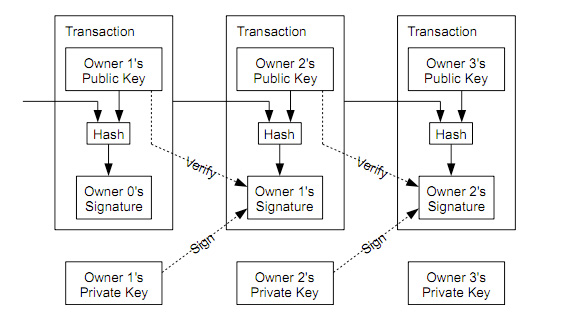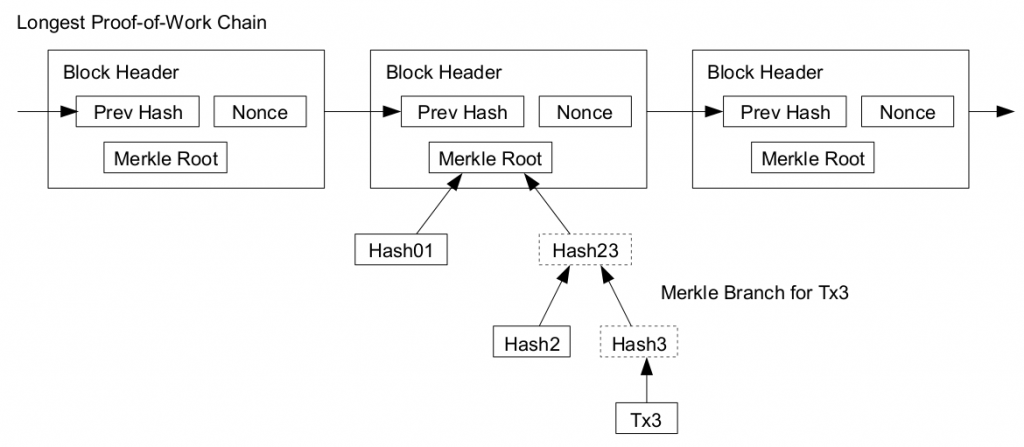Posted in December 2015
Proof-Of-Work
The blocks in the block chain are created by nodes in the network, which called miners. A miner receives transactions from other nodes in the Bitcoin network. Every transaction is verified on arrival so that an attacker cannot maliciously transmit transactions to double spend a bitcoin. But the transactions are received in a non-deterministically which causes blocks to differ from miner to miner. Thus there needs to be a method to obtain consensus on the order of transactions among the nodes. Bitcoin uses a Proof-Of-Work (POW) system based on Hashcash.
As part of the POW system, a nonce is added to every block. The nonce is just a number but it is only accepted if the hash of the whole block begins with a certain number of zeros. Miners have to find the correct nonce for their block. The miner who finds the block receives a transaction fee as incentive to expend CPU time and electricity. It is possible that multiple miners find a valid nonce at approximately the same time and notify parts of the network of their newly found block. To solve this inconsistency, Bitcoin nodes save both branches and continue using the longest branch. At some point one branch will become predominant in the network as more nodes will dedicate computing power to extend this branch and the smaller branch is then abandoned.
The average time taken to find a block in a bitcoin network should be 10 minutes. Every two weeks, the number of zeros needed in the beginning of the hash of the transaction is adjusted to compensate for the fluctuating speed of the network to find a block. The difficulty of finding a block is directly proportional to the number of zeros.
One of the alternatives to POW is Proof-of-Stake. The video below explains it in comparison to POW.
Block chain
Block chain is the main technological innovation of Bitcoin. It was introduced by Satoshi Nakamoto as a timestamp server as part of the Bitcoin protocol. A block chain is a public ledger shared by all nodes participating in a system based on the Bitcoin protocol, that is, all nodes in the network have a copy of the entire block chain. A full copy of a block chain contains every transaction ever executed. Thus it is a proof of all the transactions on the network. But what is a transaction? A transaction is a transfer of Bitcoin value which is broadcast to the network and collected into blocks. A transaction typically references previous transaction by concatenating it with the public key of the new owner and hashing it. The current owner digitally signs this hash and sends it along with the public key of the new owner. A payee can verify the signatures to verify the chain of ownership.
Every block in the block chain contains a hash of the previous block such that a chain of blocks is created from the first block of the chain, also known as genesis block, to the current block. This way the blocks are arranged in chronological order. Due to the Proof-Of-Work, it is also computationally infeasible to modify a block as every block that follows must also be regenerated. These properties prevent double-spending in bitcoins. Double spending had been a threat to digital currencies before bitcoin. This is because unlike physical money, digital currency can be easily duplicated.
Considering all nodes in the network have a copy of the block chain, if every transaction is added to the block chain, then the size of the block chain will will sooner or later become to large. Instead just the merkle root of the merkle tree formed by the transactions to find a block can be used. To compute the merkle root, copies of each transaction is hashed, and the hashes are then paired and hashed, paired again and hashed again until a single hash remains, the merkle root of a merkle tree. The merkle root is stored in the block header. Transaction verification can be performed using Merkle Hash trees without checking the transaction itself.




